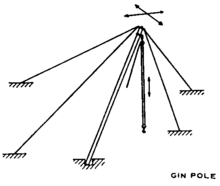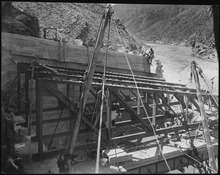Gin pole

A gin pole (derived from gyn, a three-legged lifting device) is a supported pole which uses a pulley or block and tackle on its upper end to lift loads. The lower end is braced or set in a shallow hole and positioned so the upper end lies above the object to be lifted. The pole (also known as a "mast", "boom", and "spar") is secured with three or more guys. These are manipulated to move the load laterally,[1] with up and down controlled by the pulley or block.


The gin pole is considered a form of derrick, called standing derrick or pole derrick,[2] distinguished from sheers (or "shear legs") by having a single boom rather than a two-legged one.
Gin poles are also used to raise loads above structures too tall to reach with a crane, as placing an antenna atop a steeple, and to lift segments of a tower atop one-another during erection. When used to create a segmented tower, the gin pole can be detached, raised, and re-attached to the just completed segment in order to lift the next. The process of "jumping" is repeated until the topmost portion of the tower is completed.
Gin poles are mounted on flatbed trucks as a primitive form of mobile crane, used for lifting and relocating loads, and salvage operations in lieu of a more sophisticated wrecker.
References
- ↑ Patton, William Macfarland. A treatise on civil engineering. New York: J. Wiley & sons, 1895. 1214.
- ↑ Australia, Emergency Management (2006). General and disaster rescue skills for emergency services personnel (PDF) (5th ed.). Dickson, A.C.T.: Emergency Management Australia. p. 131-132. ISBN 1921152028. Retrieved 5 July 2014.
External links
| Wikimedia Commons has media related to Gin poles. |
- Notes & drawings
- tower contractor's description with diagram
- instructions with illustrations for erecting a jin-pole as part of a mast
- jin pole regulations in Ca.
- jin pole failure leads to lawsuit april 15, 1948 in philadelphia